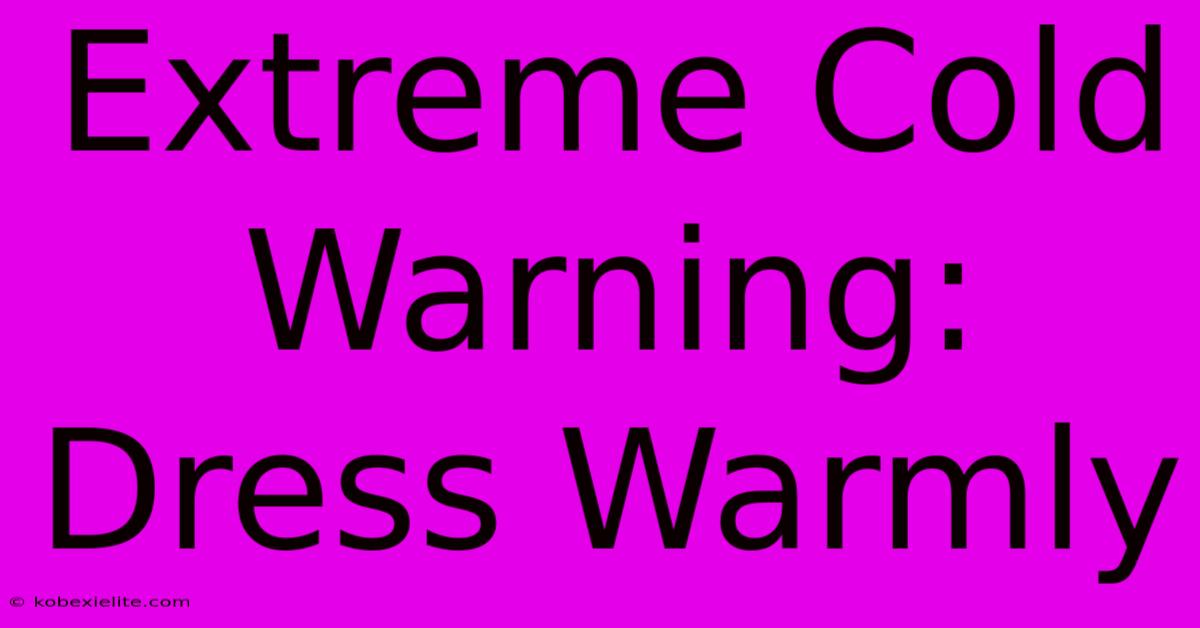Extreme Cold Warning: Dress Warmly

Discover more detailed and exciting information on our website. Click the link below to start your adventure: Visit Best Website mr.cleine.com. Don't miss out!
Table of Contents
Extreme Cold Warning: Dress Warmly to Beat the Freeze
Winter's icy grip can be dangerous if you're not prepared. An extreme cold warning isn't just a suggestion; it's a serious alert indicating potentially life-threatening conditions. Understanding how to dress for extreme cold is crucial to staying safe and healthy during these frigid periods. This guide will provide you with essential tips and advice on how to protect yourself from the dangers of sub-zero temperatures.
Understanding the Risks of Extreme Cold
Extreme cold weather can lead to a range of health problems, including:
- Hypothermia: A dangerously low body temperature that can lead to organ damage and death.
- Frostbite: Damage to body tissues caused by freezing. Fingers, toes, ears, and nose are particularly vulnerable.
- Cold-related illnesses: These can range from mild conditions like chills and shivering to more serious problems such as pneumonia.
Knowing the signs of hypothermia and frostbite is critical. Symptoms of hypothermia include shivering, confusion, drowsiness, and slurred speech. Frostbite initially presents as numbness and tingling in affected areas, followed by paleness and eventually skin discoloration. Seek immediate medical attention if you suspect hypothermia or frostbite.
Dressing for Extreme Cold: The Layering System
The key to staying warm in extreme cold is layering your clothing. This creates insulating air pockets that trap heat and protect you from the elements. A proper layering system generally consists of three layers:
1. The Base Layer: Wicking Away Moisture
The base layer is next to your skin and its primary function is to wick away moisture (sweat). Avoid cotton, which retains moisture and can make you colder. Opt for synthetic materials like polyester or polypropylene, or merino wool, which are excellent at wicking sweat and keeping you dry.
2. The Mid-Layer: Insulation
The mid-layer provides insulation. This layer traps heat and keeps you warm. Good options include:
- Fleece jackets: Lightweight and highly effective at trapping air.
- Down jackets: Excellent insulation, but can lose effectiveness when wet.
- Synthetic insulated jackets: A good alternative to down, offering warmth even when damp.
3. The Outer Layer: Protection from the Elements
The outer layer protects you from wind, snow, and rain. This layer should be windproof and water-resistant, but also breathable to allow some moisture to escape. A good quality waterproof and windproof jacket and pants are essential.
Beyond Clothing: Additional Cold Weather Precautions
Proper clothing is crucial, but several other factors contribute to staying safe in extreme cold:
- Limit your time outdoors: Minimize exposure to the elements as much as possible.
- Stay hydrated: Drink plenty of fluids, even if you don't feel thirsty.
- Eat regularly: Maintain your energy levels with regular meals and snacks.
- Protect exposed skin: Cover your face, ears, and hands with appropriate gear like a hat, scarf, gloves, and mittens.
- Check on vulnerable individuals: Make sure to check on elderly neighbors, friends, and family members who may be more susceptible to the cold.
Extreme Cold Warning: Taking Action
When an extreme cold warning is issued, take it seriously. Follow these steps to protect yourself and others:
- Stay informed: Monitor weather reports and heed warnings from local authorities.
- Prepare your home: Ensure your home is properly heated and insulated.
- Stock up on supplies: Have enough food, water, and medications on hand.
- Know the signs of cold-related illnesses: Be aware of the symptoms of hypothermia and frostbite.
- Plan ahead: Avoid unnecessary travel during extreme cold weather.
Staying safe during an extreme cold warning requires preparation and awareness. By following these tips, you can significantly reduce your risk of cold-related illnesses and injuries. Remember, your safety is paramount. Don't hesitate to seek shelter if you feel you are at risk.

Thank you for visiting our website wich cover about Extreme Cold Warning: Dress Warmly. We hope the information provided has been useful to you. Feel free to contact us if you have any questions or need further assistance. See you next time and dont miss to bookmark.
Featured Posts
-
Dwyane Wades Kidney Half Gone
Feb 01, 2025
-
Highlights India Vs England 4th T20
Feb 01, 2025
-
5 Year Old Killed Michigan Chamber Explodes
Feb 01, 2025
-
Buttler On Rana Indias Selection Choice
Feb 01, 2025
-
Priest Defrocked Musk Salute Pro Life
Feb 01, 2025
